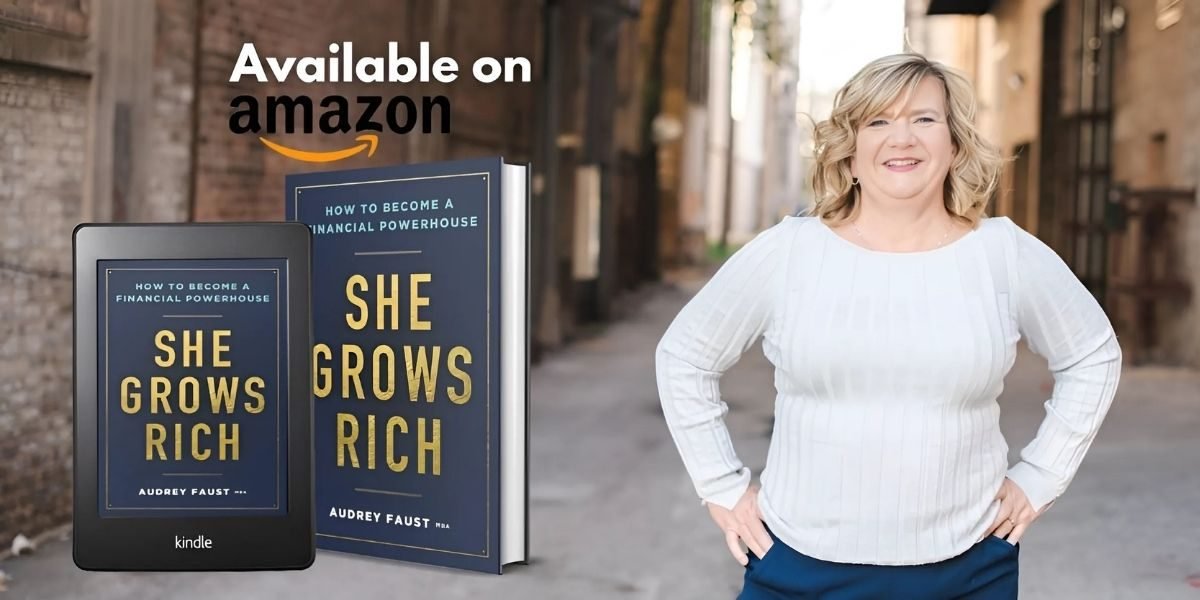By: Megan Jobs
Audrey Faust’s She Grows Rich is more than a book about finances—it’s a guide to empowerment, offering women practical insights and a mindset shift to help them work toward financial independence. In our interview, Audrey shared her journey to wealth-building, the challenges women face around money, and how her book aims to reduce barriers and foster progress.
From Humble Beginnings to Financial Empowerment
When asked about the inspiration behind She Grows Rich, Audrey explained how friends encouraged her to share her story of growing her wealth from nothing to a multi-six-figure net worth over time. Initially hesitant, Audrey reflected on her journey and realized it was a story worth telling—not just for personal validation but to inspire others. “I hope to share it in a way that helps women move toward financial independence,” she says.
Audrey’s book highlights the unique challenges women face in building wealth, from subconscious beliefs about money to fears around financial decision-making. “Many of us grow up with beliefs about money that unknowingly influence our decisions,” she explains. In “She Grows Rich”, she refers to these as “prosperity blockers” and provides tools to recognize and begin addressing them.
One such challenge is the misconception that managing finances or investing is too complicated. Audrey simplifies these concepts, dedicating an entire chapter to investing. “Many women think they’re not good with numbers or find investing intimidating,” she notes. “I aim to break it down so it feels more accessible.”
Mindset: The Foundation of Financial Success
A key focus of She Grows Rich is mindset. Audrey offers approaches for shifting from a scarcity mindset to one of abundance. “In the book, I outline techniques to help identify mindset blocks around money,” she shares. Mantras are another tool she employs, weaving them throughout the book to help counteract feelings of lack and insecurity.
This focus on mindset ties directly to confidence and self-worth—qualities Audrey emphasizes are crucial to wealth-building. “Learning about finances can help women feel more confident,” she says. By demystifying financial concepts, Audrey’s book seeks to equip readers with the knowledge they need to take control of their finances.
Actionable Strategies for Financial Growth
One of the standout strategies in She Grows Rich is Audrey’s 7% rule, a framework for deciding whether to pay off debt or invest. “This is a principle I’ve relied on for years to guide financial decisions,” she explains. The principle is straightforward: prioritize paying off debt with interest rates above 7%, but consider investing if the rate is lower. “I still have some debt, but none of it carries interest above 7%,” she adds, presenting an alternative perspective to the idea that all debt must be eliminated to achieve financial success.
Audrey also challenges common beliefs about wealth, such as the idea that the debt-free model is the only path to success. “Not all debt is inherently bad,” she says, explaining that focusing solely on paying off debt can stem from a scarcity mindset. Her approach encourages a more balanced perspective, highlighting the potential of leveraging low-interest debt to build wealth.
Building a Legacy of Wealth
For Audrey, wealth-building isn’t just about individual success—it’s about creating a lasting legacy. She encourages women to teach financial skills to the next generation, starting with conversations about money and saving. “It’s helpful to talk to your children about saving and investing early,” she advises. Whether it’s opening a Roth IRA as soon as they start working or simply discussing the importance of saving, these lessons can set young people on a path to financial independence.
Audrey’s financial journey began in her twenties when an article in Money Magazine inspired her to start investing. The article featured a couple who consistently invested a modest amount each month and managed to accumulate a significant sum over 20 years. “I saw what was possible and wanted to try it,” Audrey recalls. She started with $50 per month, gradually increasing her contributions, and remained consistent.
Her time working at Vanguard further deepened her financial knowledge. “I realized investing is more straightforward than it often seems,” she says. Through her experiences, she became passionate about empowering women to take charge of their finances and overcome their apprehensions.
One of the hallmarks of She Grows Rich is its simplicity. Audrey prides herself on making financial concepts easy to understand and apply. “When you set aside fear and are open to learning, wealth-building becomes far less intimidating,” she says. Her clients consistently praise her ability to break down complex topics into manageable steps.
For women ready to embark on their financial journey, Audrey’s advice is clear: just start. “Even if it’s $50 per month in a mutual fund, taking action is key,” she emphasizes. Her message is one of encouragement, showing women that they don’t need to be experts to take steps toward greater financial confidence.
In She Grows Rich, Audrey Faust offers more than financial advice—she provides a pathway to empowerment, education, and meaningful change. Whether you’re just beginning your wealth-building journey or looking for strategies to grow your assets, her book is an invaluable resource for women ready to evolve their financial stories.
Find She Grows Rich on Amazon Today.
Disclaimer: This content is for informational purposes only and is not intended as financial advice, nor does it replace professional financial advice, investment advice, or any other type of advice. You should seek the advice of a qualified financial advisor or other professional before making any financial decisions.









